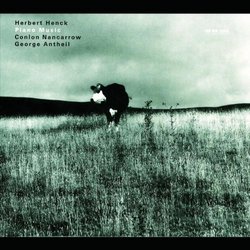| All Artists: Conlon Nancarrow, George Antheil, Herbert Henck Title: Piano Music by Nancarrow and Antheil Members Wishing: 5 Total Copies: 0 Label: Ecm Import Release Date: 6/19/2001 Album Type: Import Genres: Dance & Electronic, Special Interest, Classical Styles: Exercise, Chamber Music, Forms & Genres, Etudes, Short Forms, Sonatas, Suites, Historical Periods, Classical (c.1770-1830), Modern, 20th, & 21st Century, Instruments, Keyboard Number of Discs: 1 SwapaCD Credits: 1 UPC: 028946582923 |
Search - Conlon Nancarrow, George Antheil, Herbert Henck :: Piano Music by Nancarrow and Antheil
 | Conlon Nancarrow, George Antheil, Herbert Henck Piano Music by Nancarrow and Antheil Genres: Dance & Electronic, Special Interest, Classical
|
Larger Image |
CD Details |
CD ReviewsInteresting program but short timing and not always the best Discophage | France | 04/04/2007 (3 out of 5 stars) "Though there were hardly any personal ties between the highly mundane and self-styled "Bad Boy of Music" George Antheil, and Conlon Nancarrow (who lived in complete isolation in Mexico and found his compositional prompting in the famous book of Henry Cowell "New Musical Resources"), the pairing of these two composers is particularly appropriate and welcome. In the early 1980s Nancarrow become belatedly famous for his vast output of studies for the player piano, and he was led to the use of that "new musical resource" by his dissatisfaction with the possibility for a human player to execute his enormously complex rhythmic ideas. The five early pieces featured on this disc are interesting in that they show where Nancarrow comes from: a blend of jazz and exuberant (or stern and pointillistic as in the 2nd etude) contrapuntal quasi neo-classicism. In them you can already hear the player piano.
The link with Antheil is here obvious. In the early '20s, Antheil developed a unique style of composition for the piano, borne in a large measure from his fascination with machines. Not only the titles of his compositions but also his performance indications bear witness to that fascination: "Mechanisms", "Machine", Sonata "Death of the Machine", "Airplane Sonata", "to execute cleanly and with even touch and dynamics like a player piano", "mechanistically" - not to forget his (in)famous "Ballet Mécanique". Apparently his piano playing was of the same ilk. The famous German critic Hans Heinz Stuckenschmidt, whom Antheil had befriended upon his arrival in Germany in 1922, wrote that "it was a synthesis of frenzy and precision that went beyond conventional virtuosity. A machine seemed to be running over the keys. Rhythms of incredible difficulty and complexity were combined. Dynamics and tempi were brought to extremes." That said, Henck's readings are not always satisfying. In Nancarrow's "Prelude" and "Blues", he is somewhat teutonically heavy-handed when compared to the dazzling (and much better recorded) Cheryl Seltzer (Nancarrow: Pieces Nos. 1 & 2; ¿Tango?; String Quartet No. 1). As for Antheil, in the 1922/2 "Jazz Sonata", Henck, like Benedikt Koehlen in an otherwise fine recital (George Antheil: Bad Boy's Piano Music, see my review), appears to have read only the beginning of Antheil's indication to play "as rapidly as it is possible", omitting the remainder of the instruction "...to execute cleanly and with even touch and dynamics like a player piano". In the process he applies too much legato and looses the impression of a mechanical player piano. Likewise in the 3rd Sonata "Death of the Machine" (1923), the distant and resonant sonic perspective added to Henck's excessive pedalling and rushed tempo rob the music of the razor-sharp, machine-like articulation it needs (and that Koehlen brings to it). Taken again at a pressed tempo, the 1923 "Little Shimmy" sounds machine-like all-right but looses much of the nonchalant bluesy quality that Marthanne Verbit (George Antheil, Bad Boy of Music) or Stephen Schleiermacher (Music at the Bauhaus) so finely conjure. On the other hand, Henck's approach works better in the 1921 "Airplane Sonata". In its 1st movement Antheil instructs to play "as fast as possible", and Henck's relative blurring of articulation is offset by the sheer hectic feeling raised by his precipitous tempo. His forward-moving tempo in the second movement "andante moderato" keeps a shape to the music, which is more than Verbit's and Koehlen's slower approach manages to do. In the 1923 "Sonata Sauvage", Henck's hectic drive and unleashed gusto produce wonderful and savage energy (if not, in the finale, the "xylophonic" sounds explicitly called for by Antheil, that Koehlen captures better). "Mechanisms" is an extraordinary 8-movement Sonata and, for once, it only rarely pounds in the course of its circa 10 minutes. Henck plays it at a more animated tempo than Koehlen but with a fine sense of atmosphere. The two readings are vastly different but present equally valid alternatives. "Machine" is one of the last Preludes from Antheil's cycle "La Femme 100 têtes" (literally "The Woman One Hundred Heads", which phonetically can mean "The Woman without a head" or "The Woman stubbornly persists" - see my review of Koehlen's recording of the complete cycle, Piano Pictures: Satie Sports & Divertissements / Antheil La Femme 100 têtes), and Henck takes it at moderate but not excessively slow tempo that allows for muscular attack and clear, machine-like articulation. Same can be said with the Sonatina for Radio from 1929, which at Henck's hands (muscular, boisterous and cleanly articulated, not too fast) acquires an almost French neo-classic quality reminiscent of Satie, Poulenc and Milhaud. Still, at 38:48 (and not the 40:48 indicated on the back cover), this disc is shamefully short - the complete "La Femme sans tête" could have been included. For Nancarrow, go to the Continuum recording mentioned above, or to Studies & Solos. For Antheil's early, mechanistic works, Koehlen's collection is a better choice and should be your disc of Antheil's piano music if you have only one, to which fans are advised to add Koehlen's "La Femme 100 têtes" and possibly Verbit's recital. Henck is for completists only, with bucks to spare. " |

 Track Listings (19) - Disc #1
Track Listings (19) - Disc #1